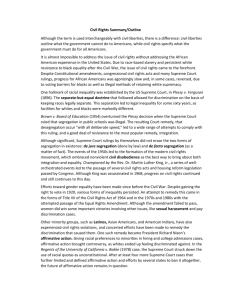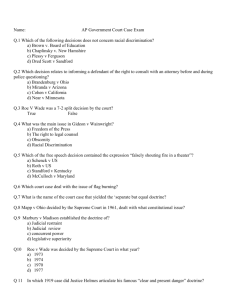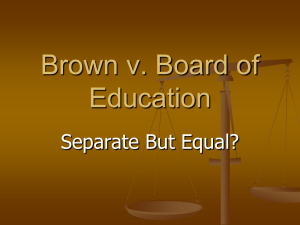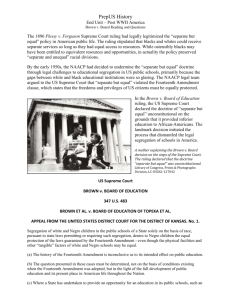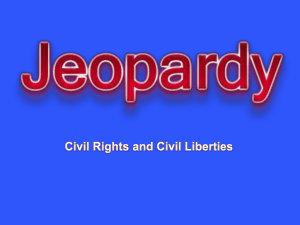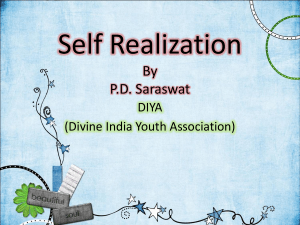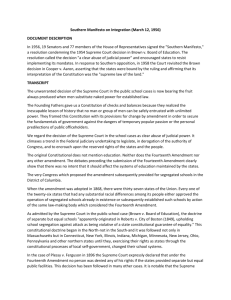Landmark Supreme Court Cases Lesson Plan
advertisement
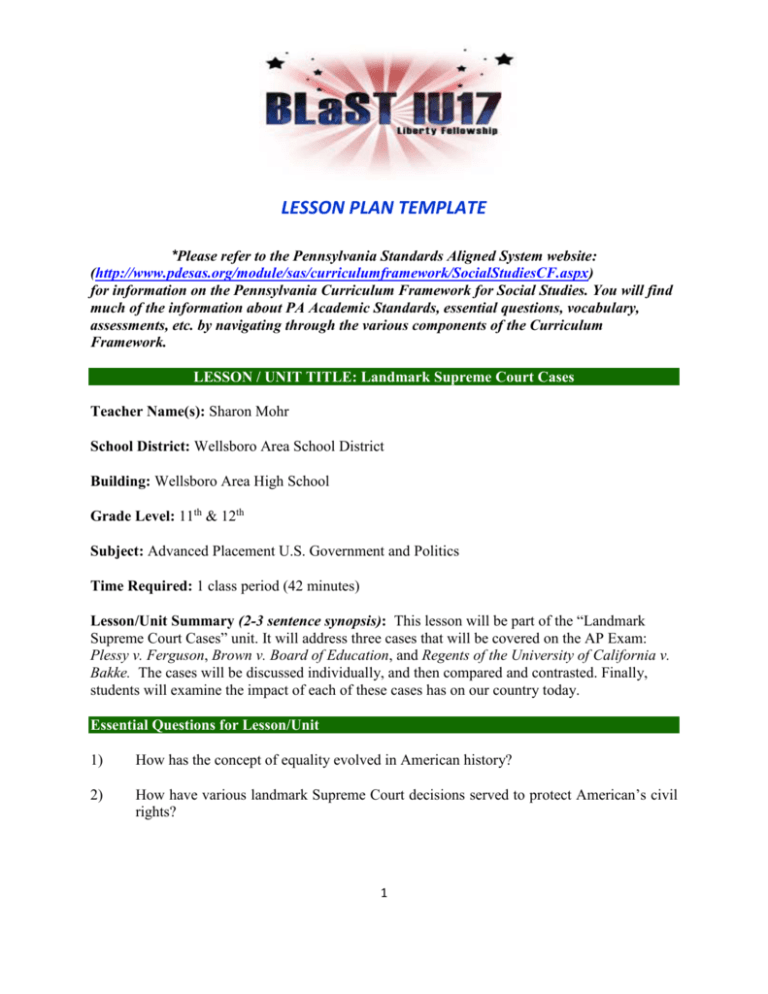
LESSON PLAN TEMPLATE *Please refer to the Pennsylvania Standards Aligned System website: (http://www.pdesas.org/module/sas/curriculumframework/SocialStudiesCF.aspx) for information on the Pennsylvania Curriculum Framework for Social Studies. You will find much of the information about PA Academic Standards, essential questions, vocabulary, assessments, etc. by navigating through the various components of the Curriculum Framework. LESSON / UNIT TITLE: Landmark Supreme Court Cases Teacher Name(s): Sharon Mohr School District: Wellsboro Area School District Building: Wellsboro Area High School Grade Level: 11th & 12th Subject: Advanced Placement U.S. Government and Politics Time Required: 1 class period (42 minutes) Lesson/Unit Summary (2-3 sentence synopsis): This lesson will be part of the “Landmark Supreme Court Cases” unit. It will address three cases that will be covered on the AP Exam: Plessy v. Ferguson, Brown v. Board of Education, and Regents of the University of California v. Bakke. The cases will be discussed individually, and then compared and contrasted. Finally, students will examine the impact of each of these cases has on our country today. Essential Questions for Lesson/Unit 1) How has the concept of equality evolved in American history? 2) How have various landmark Supreme Court decisions served to protect American’s civil rights? 1 LESSON PLAN TEMPLATE Pennsylvania Academic Standards Addressed in Lesson/Unit (Include standards numbers and standards statements.) Civics & Government 5.2.12.A: Evaluate an individual's civil rights, responsibilities and obligations in various contemporary governments. Civics & Government 5.3.12.F: Analyze landmark United States Supreme Court interpretations of the Constitution and its Amendments. Lesson/Unit Objectives 1) To understand the role of landmark Supreme Court cases in shaping Americans’ civil rights. 2) To determine how civil rights have evolved from 100 years ago to modern day. Vocabulary/Key Terms for Lesson/Unit Civil Rights – all rights rooted in the Fourteenth Amendment’s guarantee of equal protection under the law Fourteenth Amendment – amendment to the U.S. Constitution that guarantees all U. S. citizens equal protection under the law Judicial Review – the power of the Supreme Court to declare unconstitutional federal or state laws and other acts of government Precedent – a court rule bearing on subsequent legal decisions in similar cases; used by judges in deciding cases Separate But Equal Doctrine – the doctrine holding that segregation in schools and public accommodations does not imply that one race is superior to another, and that separate but equal facilities do not violate the equal protection clause Discrimination – depriving an individual or group of his/her civil rights 2 LESSON PLAN TEMPLATE Affirmative Action – a policy in educational admissions or job hiring that gives special consideration or compensatory treatment to traditionally disadvantaged groups in an effort to overcome present effects of past discrimination Reverse Discrimination – the charge that an affirmative action program discriminates against those who do not have minority status Historical Background for Teachers / Research Narrative (Insert a 2-3 page abstract that details your research on the lesson/unit topic. This is where you get to share your scholarship with your peers. You should provide enough information that a teacher could potentially teach the lesson/unit and answer general questions based on studying your narrative. Landmark Supreme Court Cases: Civil Rights This 42-minute lesson will introduce three landmark Supreme Court cases that are likely to appear on the Advanced Placement U.S. Government and Politics exam: Plessy v. Ferguson (1896), Brown v. Board of Education of Topeka (1954), and Regents of the University of California v. Bakke (1978). While these cases span almost 100 years, each has a place in the history of civil rights in the United States. The 1896 Plessy v. Ferguson decision established the “separate-but-equal” doctrine in the United States. Homer Plessy was a Louisiana resident who as 1/8 African American. In 1892, he boarded a train in New Orleans. The conductor made him leave the car because it was restricted to whites and forced him into a car for non-whites. At this time, there was a state statute that provided for separate railway cars based upon race. Plessy took the case to court using the Fourteenth Amendment argument of separate but equal. In 1896, the Supreme Court ruled against Plessy, stating that the Fourteenth Amendment “could not have been intended to abolish distinctions based upon color, or to enforce social…equality.” They contended that segregation alone did not violate the Constitution. This decision became the basis for the separate-but-equal doctrine: “Laws permitting, and even requiring, their separation in places where they are liable to be brought into contact do not necessarily imply the inferiority of either race to the other.” For the next 58 years, the Plessy decision became the judicial cornerstone for racial discrimination throughout the United States, especially in the Jim Crow south. 3 LESSON PLAN TEMPLATE In 1954, the Brown v. Board of Education of Topeka overturned the Plessy decision of 1896, effectively abolishing the outdated and discriminatory separate-but-equal doctrine. In 1951, Oliver Brown decided that it was unfair that his eight-year-old daughter, Linda Brown, should have to walk twenty-one blocks to a non-white elementary school, when there was a white school only seven blocks away. The National Association for the Advancement of Colored People (NAACP) supported Oliver Brown in the case he took to the United States Supreme Court. In 1954, the Supreme Court ruled that segregation of races in the public schools violated the equal protection clause of the Fourteenth Amendment. Chief Justice Earl Warren stated that separation implied inferiority; thus the separate-but-equal doctrine and the Plessy decision were overturned. Beginning in 1955, the Supreme Court declared that lower courts needed to ensure that African Americans would be admitted to schools on a nondiscriminatory basis with “all deliberate speed.” While this precedent set by the highest court in the United States should have assured integration of public schools, many schools in the south still resisted. One incident in particular involved Governor Orval Faubus and the Central High School in Little Rock, Arkansas. Another involved James Meredith, an African American, who wanted to enroll at the University of Mississippi. In both of these situations, federal troops needed to be dispatched to assure that the Supreme Court’s mandate was carried out. For twenty-five years, efforts were made by the legislature and the judiciary to compensate for past discrimination against minorities, like African Americans. Affirmative action programs were begun to serve this purpose. A more recent decision involving civil rights is the Regents of the University of California v. Bakke decision of 1978. This is the first Supreme Court case to address the constitutionality of affirmative action, as it challenged an admissions program at the University of California at Davis. Allan Bakke, a white student, was turned down for medical school admission. He discovered that his academic record was better than those of some of the minority applicants who had been admitted to the program. He sued the University on the grounds of reverse discrimination. The University had a policy to hold a specified number of slots for educationally “disadvantaged students” and admitted to using race as a criterion for those slots. Bakke claimed that his exclusion from medical school violated the Fourteenth Amendment’s provision for equal protection under the law. Bakke won his case in trial court and again at the state supreme court; however, the University appealed the case to the United States Supreme Court. In 1978, the Supreme Court held that Bakke must be admitted to the medical school because its admission policy had used race as the sole criterion for the sixteen minority slots. The Court ruled that while race can be considered a factor among others in admissions and hiring decisions, race cannot be the sole factor. In other words, affirmative action programs were upheld as constitutional; however, specific quota systems were not. 4 LESSON PLAN TEMPLATE Instructional Prodedures and Activities (List/describe the step-by-step sequence of procedures and learning activities. 1) Review the concept of civil rights and the idea of precedents establishing some of our current civil rights. 2) Review the guided reading on the Brown v. Board of Education decision and complete questions aloud in discussion format. (Students will have completed reading as homework in preparation for today’s discussion.) 3) Within the guided reading, it will be necessary to review the Plessy v. Ferguson decision via class discussion. 4) Compare and contrast the Brown v. Board of Education decision with the Regents of the University of California v. Bakke decision via the Landmark Discrimination cases reading and worksheet. Read individually and then discuss as a class. 5) Read and discuss 2 quotes by Justice Thurgood Marshall. Examine them within the perspective of the 1950’s. Then explore them in the context of today. 6) Complete lesson wrap-up activity. Students will complete 3 Supreme Court case cards. Card should include case name on one side and on the other they should list the Constitutional issue at hand, the historical time period when the case was decided, the outcome of the case, and the implications for today. (Cards with then be used as a study tool for the AP Exam.) Suggested Strategies for Differentiating Instruction N/A – all learners are at the AP level and do not require differentiation. 5 LESSON PLAN TEMPLATE Assessment of Student Learning (Formative and Summative) Formative Assessment = Students will ask and answer questions regarding the three cases; Students will provide their own interpretations of cases and their decisions; Students will interpret quotes in the context of two historical time periods; Students will complete case cards at the end of the lesson. Summative Assessment = Students will take a Landmark Supreme Court Case Test at the conclusion of the entire unit. Materials and Resources (Include text, supplementary resources, primary source documents, websites, handouts, charts, maps, etc.) Course Textbook: Schmidt, S. W., Shelley, M. C., & Bardes, B. A. (2007). American Government and Politics Today (2007 – 2008 edition). Belmont, CA: Thomson/Wadsworth. CICERO website: *Unit 14 – Cold War Era (all will be printed as used as handouts) -Brown v. Board of Education (Secondary Guided Reading) -Landmark Discrimination Cases (Student Activity) -Cold War Era Quotes by Justice Thurgood Marshall (At a Glance) Author(s) of Unit/Lesson Plan Sharon Mohr, Wellsboro Area High School 6
